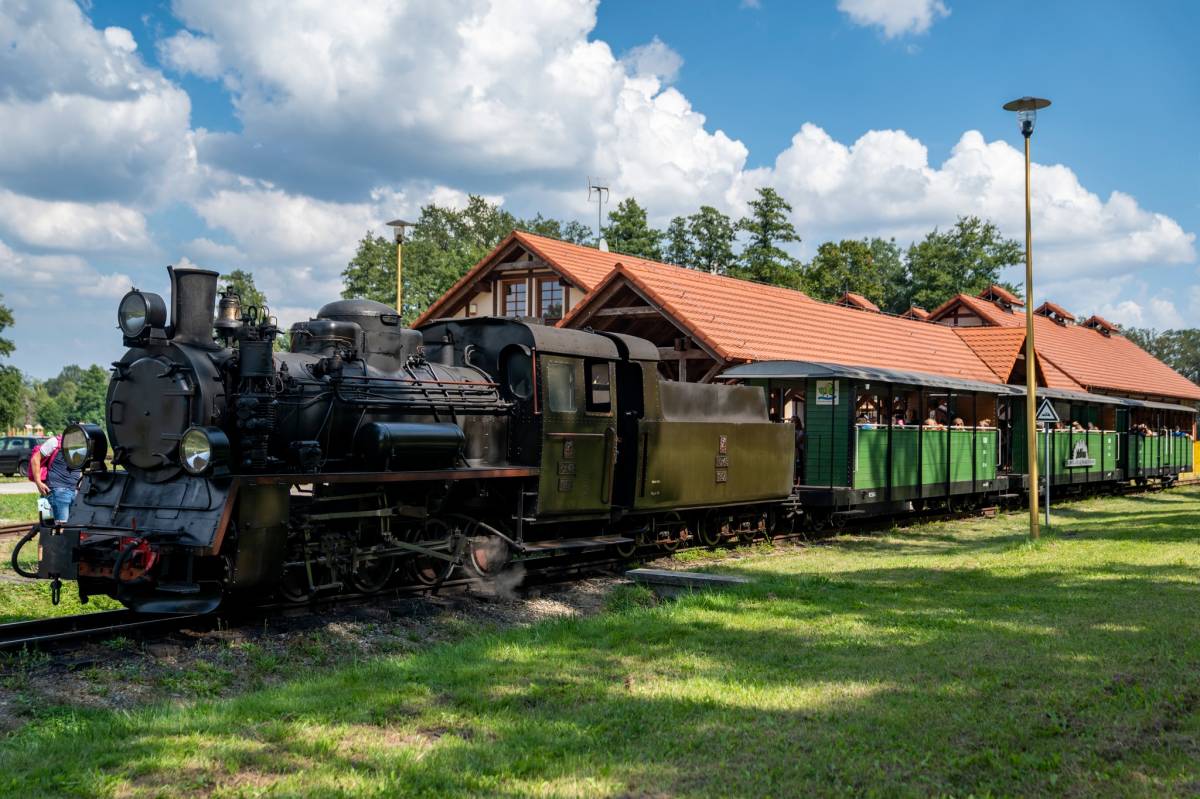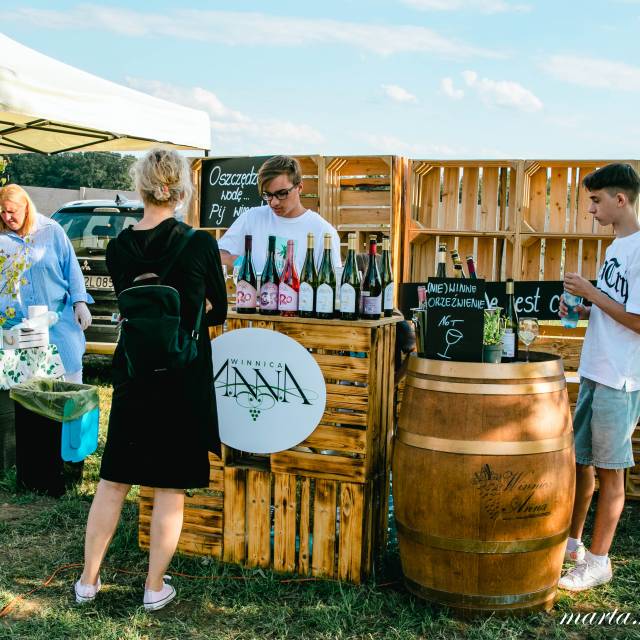The TOP 10 attractions of the Krosnice commune
Mural of Ryszard Szurkowski in Krosnice
The mural of Ryszard Szurkowski - an outstanding Polish cyclist of all times, was created in September 2024 in his hometown - on the building of the School Complex in Krosnice (our Master was born and grew up a few kilometers away, in Swiebodow). The mural has an area of 100 m2. It is easy to find also because it is located on a building located on the provincial road no. DW439 Milicz - Syców. Since its appearance it has aroused a lot of interest among local residents and attracted Szurkowski's fans.
The author of the mural's design and execution on the wall is Konrad Moszyński, a graphic artist from Ostrów Wielkopolski, the author of two other murals in our area - Nicolaus Copernicus and Wisława Szymborska in Milicz. The Szurkowski mural was inspired by a photograph taken during one of Ryszard Szurkowski's victorious races from the collection of the East News Agency. Just a reminder that the period of greatest successes of the world-class cyclist from Swiebodow was the 1970s: two-time Olympic vice-champion (1972 in Munich and 1976 in Montreal), four-time World Cup medalist, and twelve-time Polish champion, best known for dominating the Peace Race for several years in a row. The dates and races in which Szurkowski won are also included in the mural. The figure of the cyclist is depicted in a very dynamic way, the face shows the effort and determination with which the champion won successive podiums. The retro-style color scheme alludes to the 1970s, the period when Szurkowski reached the peak of his career.

fot. Konrad Moszyński
Krosnice Narrow Gauge Railway
There are 5 smaller stations along the route. The pride of Krosnica's rolling stock is the Px48-1907 steam locomotive produced in 1955 at the Chrzanów Locomotive Factory. As a curiosity it is also worth mentioning that years ago the same steam locomotive drove in the Milicz region. So we are dealing with a touching homecoming. The Krośnicka Railway is one of the few active narrow gauge railways preserved in Poland. It was launched on 25 May 2013. The Krosnica Narrow Gauge Railway is also an ideal place for school groups, who often combine their stay on the railway with the offer of the Environmental Education Centre in Krosnice, participating in numerous workshops. The main station building houses the Tourist Information Centre and the railway bar. Two exhibition steam locomotives are set up next to the station. Near the main station, there is a barbecue shelter, a recreational pond with a swimming area open in July-August, a boat and pedal boat rental, as well as a playground and a paid children's area (inflatables, dry pool, battery cars, paddle boats).
The site is a BICYCLIST-FRIENDLY PLACE

Photo: Łukasz Gościniak
The Krosnicka Przystań Aquapark is a swimming pool with a movable bottom, which opened in August 2015. The two-storey facility houses, among others, a 25-metre swimming pool equipped with a moving bottom, a recreational tank equipped with a tube slide, whirlpools and water spouts, and a paddling pool for children. There is also a saunarium with a spa area, fitness room, gym and bicycle rental. The first floor of the swimming pool hall has seating for approximately 150 people. The swimming pool is directly connected with the sports hall and the school. The facility is accessible to people with disabilities.

Photo: Communal archive
Nature trail "Stawy Krośnickie" (Krosnice ponds)
The trail has the form of a 9 km long loop. It leads mainly along the dikes of 11 ponds belonging to the complex of the Fisheries Plant in Krośnice, which is subordinate to the State Budgetary Plant "Stawy Milickie" in Ruda Sułowska. These are breeding concessions, so it is only possible to walk along a marked path agreed with the above-mentioned land manager (two ponds - Grunda and Policki are outside the scope of the nature trail). The path can be travelled on foot or by bicycle in organised groups under the supervision of a guide. It is marked with white 10x10 cm squares painted on tree trunks, with a green diagonal band. The approach (access) to the nature trail is about 1.5 km on a paved road, leading from Kolejowa Street in Krosnice (near the railway station). A red marked hiking trail and a black marked bicycle trail lead along it, allowing one to get here from the Education, Sports and Tourism Centre in Krosnice.

Photo: Marta Kamińska
Palace of Volmerstein, now Municipal Office
The palace was built around 1785 by the Reichenbach family from Goszcz. At the time, the manor house was single-storey and much smaller than it is today. It remained under their management for sixty years. On 22 July 1845, the estate was purchased from Count Heinrich by Count Adelbert von der Recke von Volmerstein, who came from Westphalia. He founded the Foundation, which began to organise the work of the Krosnice medical centre. In the same year, the palace was rebuilt from baroque to neo-Renaissance style. The Neo-Renaissance style of this building was probably taken from Italian models. It was the largest palace in the area at the time, second only to the residence in Brzostów.

Photo: Marta Kamińska
Ore houses
At the end of Kolejowa Street in Krosnice, on the road to the Krosnice Ponds, there are houses built from ore. There used to be a smithy here, where ore mined at the sites where the ponds were later established was processed. The smelting plant was located in the western part of the present Krosnice, formerly known as Kuźnica and Ore Krosnice. Ore houses were built in 1876. Ore used to be mined in this area and iron was smelted from it in special smelters. In former times, this area was quite poor and the inhabitants were keen to use the cheap, available raw materials to build houses and buildings. Hence, many of the elements in the various buildings are made of bog iron ore (orecrete), field stones or clay and reeds. Ore is a sedimentary rock, the poorest of all iron ores. Due to its widespread occurrence and ease of exploitation, it was used by metallurgists in Poland from ancient times until the mid-20th century. The bog iron ore precipitates from the waters in marshes and wet meadows. It is a geologically interesting formation, as its deposits, once exploited, are able to recover within a few decades under favourable water conditions. The extraction of turf ore once devastated the area, but the hollows left behind were turned into ponds, which in turn contributed to the current richness of the Barycz Valley.

Photo: Marta Kamińska
Aeroplane Yak-11
At the Youth Hostel in Krosnice, there is a Soviet training aircraft Yak-11. Its design was created in the design office of Alexander Yakovlev. The plane was produced after the war and was based on solutions from the Yak-3. It was also manufactured under licence in Czechoslovakia under the designation C-11. The plane has been in Krosnice since the early 1960s. It was probably brought from an airport in Poznań. It was influenced by Colonel Jan Kowalewski's good relations with the hospital management. It was brought and assembled within two days by Oleśnica soldiers. Since then, it has diversified the space of the village.

Photo: Marta Kamińska
Gęślica Hill 242 m above sea level
From the village of Dziewiętlin, following the green trail, we will reach the highest hill of the Krośnice commune and the Milicz land - Gęślica (242 m above sea level). The hill is overgrown with beech forest. There is a fire tower on the spot (keys at the Milicz Forestry Office), and from the hill itself there is a view of the hills and forests of the entire commune. Below, at the fork of the forest roads, there is a shelter and a barbecue - a resting place.
The Anna vineyard is located in Krosnice. Five grape varietals are grown on 2 ha, two white and three red. Wines here are made using the natural method, without any enhancers. The owners focus on high quality, which is why they have chosen the strains that grow best in the climate of Lower Silesia. From April to October, a tour of the vineyard combined with wine tasting is organised, but you need to make an appointment in advance by phone or e-mail.
The facility is a PLACE FRIENDLY TO CYCLING

Fot. Marta Kamińska
De Sas Winery
The winery is located in the picturesque village of Czeszyce, about 17 km from Krosnice. Seven grape varieties are grown here, most of them Gewuertztraminer, using ecological solutions. A large acreage is occupied by Riesling and Solaris, in addition to which we have several rows of Regent, Pinot Noir, Pinot Gris, Dornfelder. It is from these varietals that the wines are produced. The winery organises team-building events, occasional exhibitions, wine courses, sommelier workshops, wine cooking workshops and artistic events.
Monument to Ryszard Szurkowski in Swiebodow
In Swiebodow there is a monument dedicated to the most outstanding Polish cyclist Ryszard Szurkowski. On a bicycle like the one on the monument, Ryszard Szurkowski won medals many years ago, sparking the imagination of fans. The king of Polish cycling died last year. The monument is to remind us of his achievements. The monument was erected in Świebodowo, where Ryszard Szurkowski was born. It is a local initiative of which the residents are proud.

Photo: Marta Kamińska
UG Krośnice, Justyna Jarosz




























